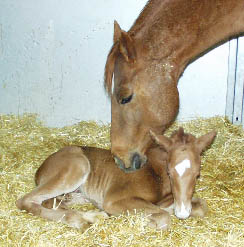Article
Foaling Fundamentals: The Top 10 List, Revised
By Patrick M. McCue, DVM, Ph.D.,
Diplomate American College of Theriogenologists
1. Due Date. Gestation Length of horses is approximately 340 days and the due date can be
calculated from the ovulation date or last breeding date. Pregnant mares should be
vaccinated one month prior to their due date to increase antibody levels in the colostrum.
Type of vaccine administered may depend on geographical location, potential exposure
and management practices. If the mare has had a Caslick procedure performed, the
sutured vulva should be opened approximately 2 weeks prior to the expected foaling date or
earlier if needed.
2. Milk Calcium levels increase as the time of foaling approaches. Most mares foal within 48
hours of when milk calcium levels reach 200 ppm. Several commercial test kits are
available to help predict when foaling will (or will not) occur.
3. Waxing of the Teats is a sign that foaling will occur in most mares within 24 to 48 hours.
Approximately 70 % of mares ‘wax-up’ prior to foaling and most give birth within 48 hours of
waxing. The ‘wax’ is actually dried colostrum.
4. Stage 1 of Labor lasts for 1-4 hours. Signs of early labor in the mare include frequent
episodes of lying down, looking at her flanks, pawing at the ground and patchy sweating.
The end of Stage 1 occurs when the mare ‘breaks her water’ or ruptures the outer placental
membrane (chorioallantois) and releases allantoic fluid.
5. Stage 2 of Labor or active labor lasts an average of 17 minutes. The first structure visible
at the vulva should be the amnion, a translucent gray membrane. Any delay in active labor
may result in decrease foal survival. A key fact is that every 10 minute delay in foaling after
30 minutes of active labor is associated with a 10 % decrease in foal survival.
6. Red-bag. The hallmark of premature separation of the placenta (‘red bag’) is the
appearance of a thick, brick-red, velvety membrane (the chorion) at the vulva during early
labor. Red bag should be considered a medical emergency as the oxygen supply to the
foal is compromised and veterinary help should be summoned immediately.
7. Establishment of an Airway and Stimulation of Breathing is a top priority when a foal
has just been born. The amnion should be removed from the nasal area if it did not break
spontaneously during foaling. Respiration may be stimulated by briskly rubbing the newborn
foal with a towel and tickling the inside of the nostrils with straw.
8. Disinfect the Navel soon after foaling to help prevent bacterial infections and help seal the
umbilical stump. Common disinfectants include dilute NolvasanÒ, BetadineÒ and Iodine.
It is recommended that the navel be dipped 2-3 times per day for the first 2-3 days after
birth.
9. 1-2-3 Rule. Foals should stand by one hour, nurse by 2 hours and pass meconium by 3
hours. Ingestion of colostrum, which is rich in antibodies, is critical for early immune
protection of the foal. Ideally, a liter or more of good quality colostrum should be ingested by
the foal within the first 6-12 hours of life. Antibody levels in the blood of the foal may be
checked 24 to 36 hours after birth to determine if adequate transfer of colostral antibodies
has occurred. However, if blood antibody levels are checked earlier (i.e. at 12 hours), oral
supplementation with frozen-thawed colostrum or a colostrum substitute can be
administered if needed.
10. Passage of the Placenta (Stage 3 of labor) should occur within 3 hours after foaling.
Failure to pass the placenta could lead to severe medical conditions in the mare, such as
peritonitis and laminitis (founder). Early medical intervention can aid in stimulating passage
of the placenta and prevention of subsequent complications.
Mare and Foal
About the Author...
Patrick M. McCue, DVM, Ph.D.,
Equine Reproduction Specialist
Associate Professor, College of Veterinary Medicine and Biomedical Sciences,
Colorado State University






